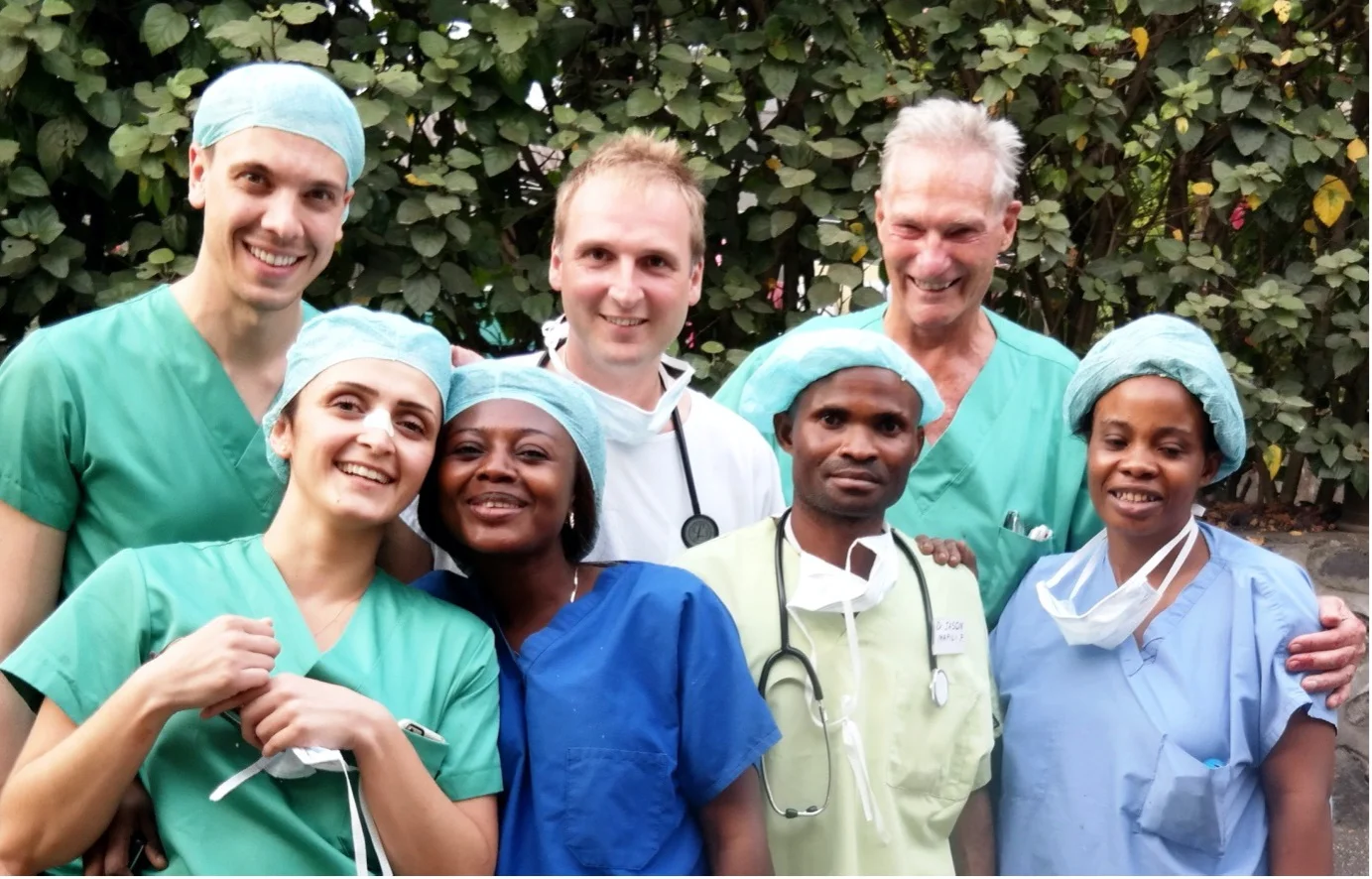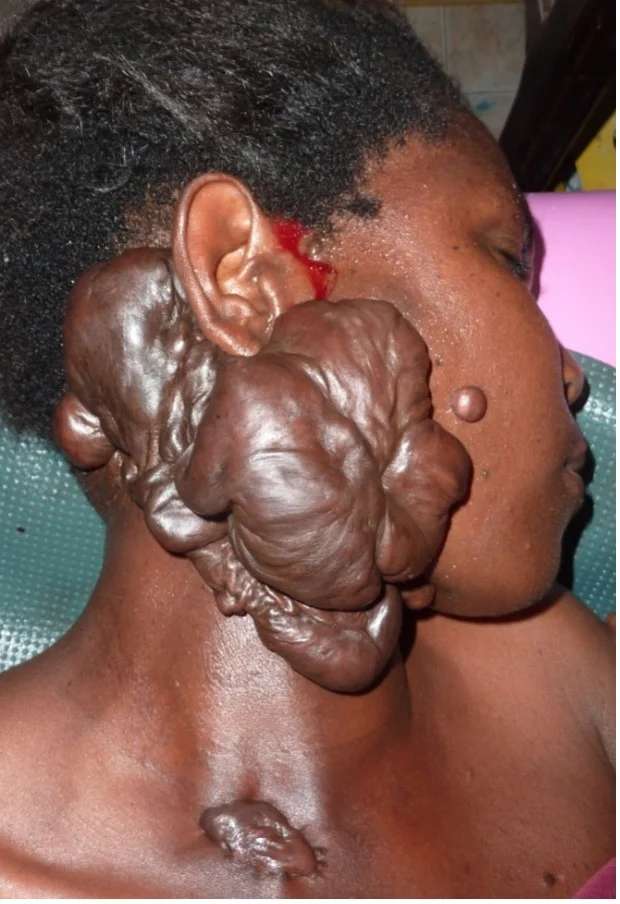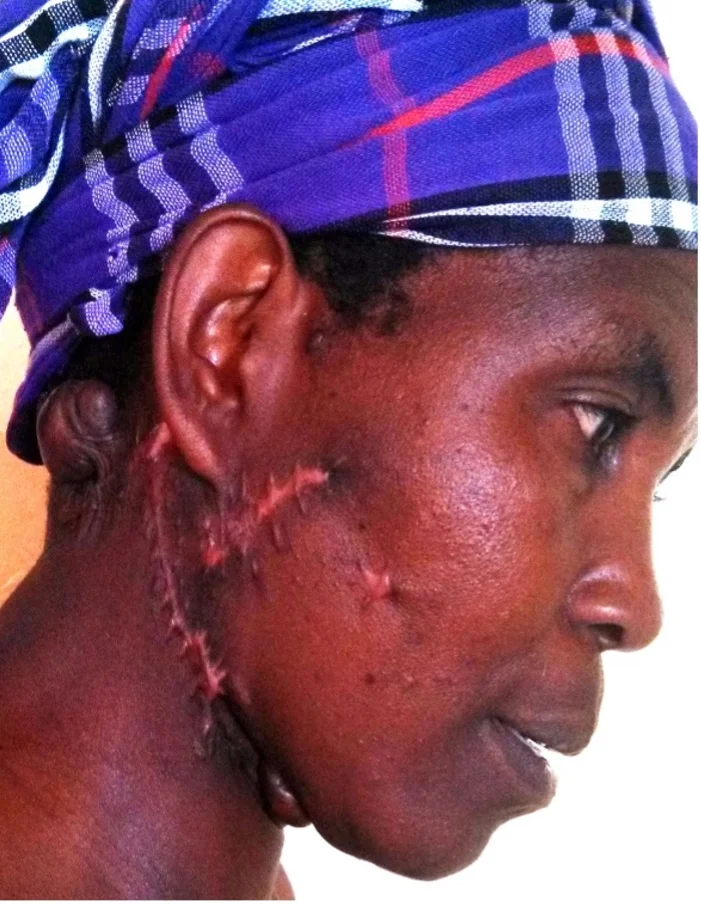Report information
- Author: Hans Jakob
- When : 6 June 2021
- About : The 3rd mission in Goma, August 2016
The 3rd mission in Goma, August 2016
Gottfried Lemperle had already reported on the first two missions in Goma, Democratic Republic of Congo. This time he found in us another enthusiastic team: plastic surgeons Christoph Sachs from Martin Luther Hospital in Berlin and Katja Kassem from Donaueschingen, and Carsten Schröder, anesthesiologist in Zurich (Fig.1).
What Gottfried considers particularly important: the involvement of local surgeons and anesthesiologists: Dr. Christophe Kimona, a former surgical chief resident and designated for our new hospital, Dr. Harmony Linda Mitila, 3rd year surgery, assistant Dr.Emilie Amisi, as well as anesthesia nurses Jason, Castram and Christian, and operating room nurses Colette and Cynthia. After all, the local surgeons should be able to take care of their plastic surgery patients themselves someday!
We were again invited by the Church of the Nazarene in Goma and its Reverend Balibanga, who convinced Dr. John Maganga at CEDIGO Hospital to also allow a 3rd Interplast team to operate in his hospital. Via Addis Ababa we flew to Goma, which was able to reopen its airport, flooded by lava masses in 2002, on February 20, 2015 with financial help from Germany and Foreign Minister Steinmeier.
Before that, a modernized Dräger anesthesia machine, as well as surgical materials belatedly begged for by Katja, arrived there in 4 super metal crates donated by the company Haas Logistig GmbH in Dunningen and shipped to Goma free of charge. Customs duties are levied everywhere in Africa not according to regulations but at the discretion of the local officer: Reverend Balibanga, however, knew his flock - and instead of customs duties probably gave him a more important indulgence blessing.
The Cedigo Hospital, today more of a blood bank with which more money can be earned than with surgery, already knew the power with which Interplast teams are accustomed to operate and was well prepared. In the approximately 30 square meter operating room there were 2 operating tables, the German anesthesia machine, a new 2nd operating lamp, a suction device and 2 trays for locales, dressings and sutures. But still no running water. The unpacking of the 3 x 4 suitcases and boxes was done under the greedy eyes of the workers, as we again brought laptops, cameras and watches and also left them our suitcases again.
Dr. Eric from the Church of the Nazarene had taken the medical histories of about 400 patients, photographed them, and ordered in 50 per surgery day. They sat patiently on the lawn in front of the hospital as we selected those to be operated on the next morning - as we did every morning: about 5 large facial tumors under anesthesia, 10 contracted hands or legs under conduction anesthesia, and about 20 keloids (Fig. 2 ud 3) and smaller excisions under local. We pushed the bed in the "recovery room" with the head end against the window so that 2 female or male patients could be placed there together, and Drs. Harmonie and Emily operated on them: many large mature keloids, mammary tumors, facial scars, neurofibromas, etc.
Disinfection was done on our hands with some soap and water from a bucket, and a few squirts of Sterisept. According to Dr. Eric, who continued to care for all patients after we left, there was not one post-operative infection, and all skin grafts healed satisfactorily.
Dr. Eric had received from Gottfried a Dermojet inoculation gun, which is usually used by veterinarians, with 2 x 100 ampoules of TRIAM 40, in order to either reduce still fresh keloids, or to prevent the keloids operated on by us from recurring after 2-3 months, if necessary. Gottfried believes that the cause of most keloids was an infection - and that recurrences after excision of "mature" keloids only occur after renewed post-operative infection. Therefore, he forced us to drip gentamicin or cefalotin on the still open wound before closing it.
Carsten took touching care of the 3 "anesthesiologists", who did not bring much theoretical knowledge. Christoph and Katja took care of the many "frozen hands" and burns, Gottfried operated on 6 large facial tumors (fibrodyplasias, sarcomas) and supervised the simpler excisions by Harmony and Emilie at the window - and Katja knew very well how to keep the two OR nurses and cleaning ladies happy and laughing all the time.
Without their good mood and their diligent washing and disinfecting of the instruments (mostly in a solution, but also in their leaky autoclave), we would not have been able to do up to 20 operations a day. Thus, in 10 surgery days, a total of 187 patients were operated on, 18 under general anesthesia, 20 under spinal or conduction anesthesia, 16 under analgesia, and 133 under local. In the more distant Ndoso Hospital of the International Red Cross, Gottfried and Carsten operated again on the two mutilated gold miners from the previous year, as well as on 2 patients with central gunshot wounds to the face.
We hardly had to worry about the aftercare: in each of the 3 patient rooms there were often 6-9 patients lying together in the 3 beds or on the floor. As soon as they were able to stand, they were discharged and often made their way home on the motorcycle cabs, i.e. still in a daze, squeezed between the driver and their relatives.
Harmony and Emily were extremely dedicated and operated mostly on their own from morning to night. Harmony is meanwhile doing her surgical training in Kinshasa, - and Katja convinced Eric not to name his 3rd newborn daughter "Gottfried" but Frieda, probably out of gratitude for a new laptop and the vaccination gun, with which he is supposed to earn something extra per shot from the wealthier keloid patients.
We would like to thank Aesculap AG in Tuttlingen, Haas Logistic GmbH in Dunningen, Einhorn Apotheke in Blumberg, Mrs. Almut Meyer, Schwarzwald-Baar Klinikum, and Liberi pacifer e.V. - without whose help this project would not have been possible.
Katja Kassem, Donaueschingen

Fig 1: The team: Christoph, Katja, Colette, Carsten, Jason, Gottfried, Cynthia.

Fig. 2 : "Mature" keloid that has reportedly stopped growing for 2 years - and is therefore an indication for surgery.

Fig. 3: 4 weeks after excision: should recurrences form, the postoperative physician had a TRIAM gun at hand, but its use did not become necessary.
